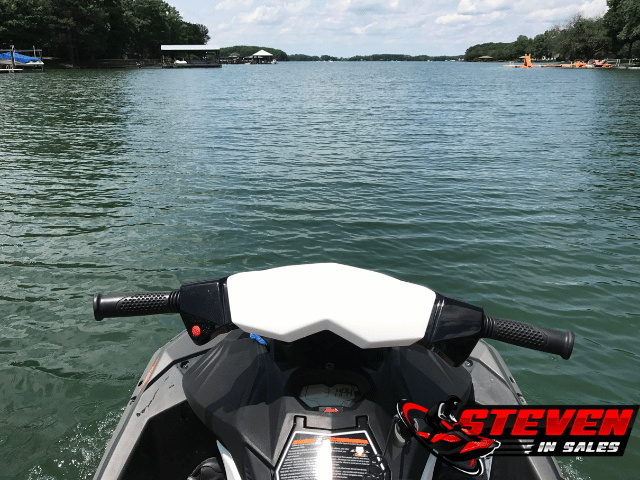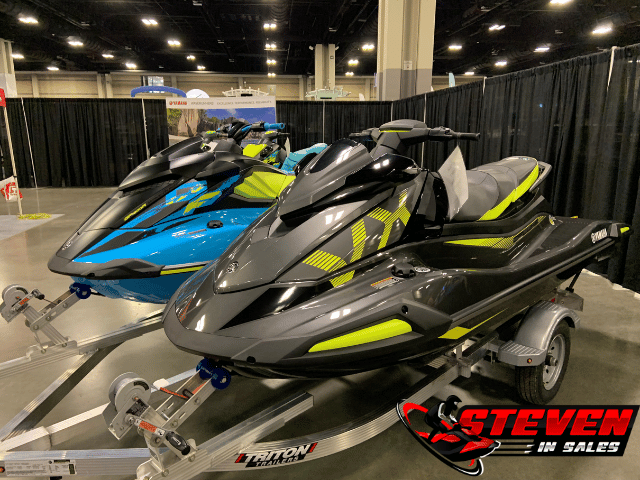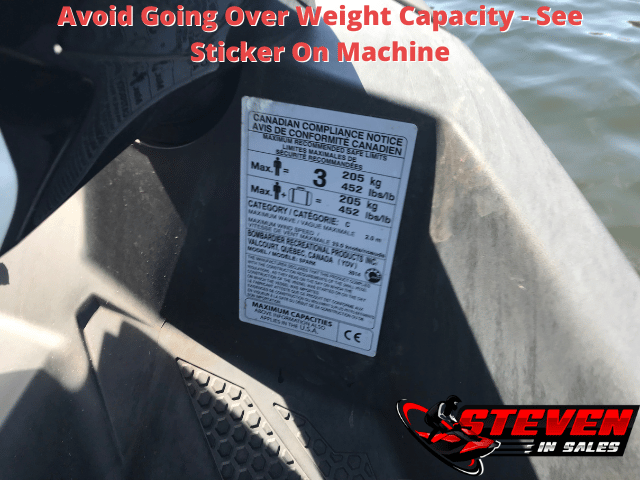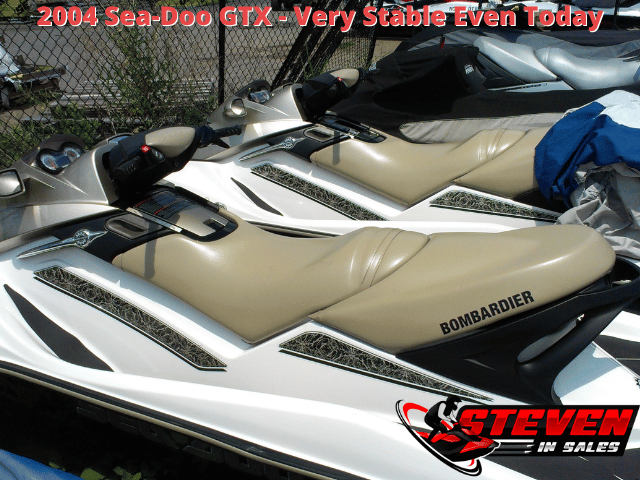Are you looking for a jet ski that doesn’t feel like it wants to roll on you? Many new riders are surprised to find that not every jet ski on the market offers stability; some prioritize playfulness over anything else.
In this guide, I aim to highlight the more sturdy machines available. I’ll outline why I believe stability is crucial, particularly for new riders, to steer you in the right direction.
To really drive this point home, I’ve listed the reasons why having a stability matters. In fact, it’s one of the biggest factors for new riders. For those that want to know, it’s often the Sea-Doo GTX, Yamaha FX HO, and Kawasaki ULTRA’s.
- Safer – I routinely find that the more stable the ride, the safer it is, especially with multiple riders. When it comes to modern jet skis, they’re more versatile than in the past, accommodating towable tubes, wakeboarders, and achieving higher speeds. A larger, sturdier ride provides increased security, visibility, and easier access from the water or dock.
- More Confidence – It can be scary for new riders, but when there’s less likelihood of flipping or rolling, it builds confidence. More confidence facilitates quicker learning, adaptation to quirks, and increases enjoyment.
- Comfort – With rising prices, people are opting for jet skis over boats due to cost. Many seek a comfortable and easy alternative to boats. A larger model offers a bigger seat and better handling in choppy waters. They’re becoming increasingly comfortable, with long-distance models designed for exploration.
- Can Do More – You can do various activities like pull sports, drag racing, cruising, and trips with a more stable jet ski. You’ll have less fatigue and more courage when you have more stability and comfort.
- Can Go More Places – A larger machine enables exploration of more places and engagement in diverse activities. For long-distance trips, ample storage space for luggage and fuel is crucial. In challenging ocean conditions, larger jet skis outperform smaller ones.
- Carry More People – You can carry more people on larger and more stable jet skis with confidence. While a good bit have a standard seating capacity for three people, there are also options for two or single-seater configurations. However, not all three-person jet skis are equal. Despite claiming to seat three individuals, some may be more suitable for two adults and a small child due to size constraints. Thus, it’s crucial to carefully consider seating capacity when buying, as not all three-seaters comfortably accommodate three adults.

What Is The Most Stable Jet Skis?
If you want comfort, ease, and a confident ride, you want to look at the following options below. You’re not going to find greater stability anywhere else.
- Sea-Doo – GTX, RXT, and anything with ST3 Hull (Wake Pro, Explorer Pro 170 and Fish Pro & Trophy).
- Yamaha – The FX line-up.
- Kawasaki – The ULTRA line-up.
The reason why Sea-Doo has many models listed is that they all share the same hull.
Manufacturers tend to have 3 or 4 different hulls, but may sell 10 to 20 different models.
For Rough Water
When it comes to rough water, the Kawasaki ULTRA hull is the best rough water hull.
Who Makes The Most Comfortable?
In the boating world, stability and comfort go hand in hand, and there is one hull that truly stands out from the competition.
The Sea-Doo ST3 hull, featured on popular models such as the GTX, RXT, Fish Pro, WAKE Pro, and Explorer Pro 170, takes the title as super comfortable.
Sea-Doo goes above and beyond in prioritizing ergonomics, offering a seat meticulously molded to conform to the human form. Additionally, the handlebars are thoughtfully adjusted to accommodate riders, ensuring a personalized and comfortable riding experience. With the added convenience of quick access storage, the Sea-Doo ST3 hull exemplifies meticulously designed jet skis that truly caters to the needs of riders.
The level of comfort that Sea-Doo delivers allows them to come out with models made for long rides, like the Explorer Pro 170.
They Keep Getting Bigger
The market demands larger watercraft, so the manufacturers are listening, and you’re seeing them get more stable.
The market demands sturdy and comfortable models while also desiring more nimble options.
Even the smallest model, the Sea-Doo Spark, remains relatively large compared to older models.
Now Vs. Then
For instance, let’s consider the Sea-Doo Spark 3up, which measures 120 inches in length. In comparison, the 1996 GTX, known as one of the larger luxury Sea-Doo during its time, had a length of 122 inches. Notably, the Sea-Doo Spark’s width is only 1 inch shorter than that of the 1996 GTX.
The difference is so minimal that the “small” Sea-Doo Spark available today is approximately the same size as the “large of its time” luxury Sea-Doo model from 1996. Moving up in size, the current Sea-Doo GTI body is actually slightly larger than the top-of-the-line Sea-Doo model of 2007, the GTX Limited.
These comparisons extend beyond Sea-Doo alone; similar trends are evident across other manufacturers too. They have steadily increased in size over the years.
This indicates that newer models generally offer improved stability due to their larger sizes.
How To Make Your Jet Ski A lot More Stable?
If you already own a jet ski or are considering one that may not provide the level of stability you want, there are several things you can do to enhance its stability:
- Ride fewer people – The more people riding, the more unstable it becomes. Stick to the weight capacity, instead of the seating capacity rating.
- Avoid Standing Up – When you or the passengers stand up, it makes the unit more top-heavy and more likely to roll. Avoid standing up too much and stick to staying low when riding.
- Carry Fewer Items – Adding more items to the jet ski affects its stability. To maintain optimal stability, it is best to only carry the needed items and avoid unnecessary weight. For example, don’t carry sand in your sand anchor, refill it every time you anchor.
- Learn To Ride In Chop – The way you approach a wave can determine if your jet ski will flip, so make sure to know how to handle riding waves. If you’re worried about stability, avoid riding on rough days and rough water conditions.
- Learn To Trim – Not every model has trim, but the ones that have it, make navigating rough water easier. In rough waters, you want to trim down a little, as the front is more sharp than the rear, so you cut through the water.
- Understand How To Drive & Dock – It’s important you understand how to drive and how to dock. You should also practice where you can, go in an empty cove and get a feel for the machine. You’ll quickly learn the quirks of the jet ski when you practice.
- Go Slow – Reduce your speed when encountering choppy or rough waters. Slower speeds allow for better stability and control, minimizing the impact of waves.
- Avoid 2-strokes – The era of 2-strokes is fading due to environmental concerns, leading manufacturers to halt their production. These models, typically smaller due to their engines, are being phased out. I suggest you stay away from 2-stroke if you’re wanting stability. Some 2-strokes were so unreliable that they required starting in the water.
Video On Why To Avoid 2-strokes
To see how unstable they used to be and why to avoid 2-stroke if you care about stability, watch the video below.
Today, you have to try to get wet on many of the bigger models. The Sea-Doo Spark and Yamaha EX are still playful, but not anywhere near as tipsy as the Sea-Doo HX back in the day.
Are All Jet Skis tippy?
Generally, units manufactured within the last 15 years boast significantly improved stability compared to older models. The industry trend towards larger models with each new iteration and design update prompts comments like “these things are the size of boats!” from many buyers.
As a large guy, I can personally attest to the stability of smaller and modern machines like the Sea-Doo Spark, which I own. Despite its compact size, I can confidently stand on its side without it flipping. While it is still possible to deliberately flip it, it requires more effort than with older models.
Larger Models
The larger ones such as the GTI and GTX provide even greater stability and give me greater encouragement when riding them.
However, it is important to note that the stability can be lessened when adding more people and weight to it.
What makes a jet ski suddenly unstable?
If you’re finding your jet ski is normally rock-solid and recently has been wanting to flip or roll over more easily, then it’s often a sign you’re taking on water.
Another reason why it will all of a sudden become unstable is that you have too much weight, either too much gear or too many riders.
There is also the possibility that it’s not being driven correctly, some have a racing hull that wants to go fast, and if you’re constantly going slow, the hull can dart and feel unstable. It’s important to buy models that fit your riding style and not because it’s the fastest model they sell.


